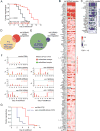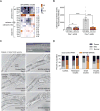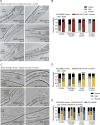Insulin Signaling Regulates Oocyte Quality Maintenance with Age via Cathepsin B Activity
- PMID: 29478855
- PMCID: PMC5893159
- DOI: 10.1016/j.cub.2018.01.052
Insulin Signaling Regulates Oocyte Quality Maintenance with Age via Cathepsin B Activity
Abstract
A decline in female reproduction is one of the earliest hallmarks of aging in many animals, including invertebrates and mammals [1-4]. The insulin/insulin-like growth factor-1 signaling (IIS) pathway has a conserved role in regulating longevity [5] and also controls reproductive aging [2, 6]. Although IIS transcriptional targets that regulate somatic aging have been characterized [7, 8], it was not known whether the same mechanisms influence reproductive aging. We previously showed that Caenorhabditis elegans daf-2 IIS receptor mutants extend reproductive span by maintaining oocyte quality with age [6], but IIS targets in oocytes had not been identified. Here, we compared the transcriptomes of aged daf-2(-) and wild-type oocytes, and distinguished IIS targets in oocytes from soma-specific targets. Remarkably, IIS appears to regulate reproductive and somatic aging through largely distinct mechanisms, although the binding motif for longevity factor PQM-1 [8] was also overrepresented in oocyte targets. Reduction of oocyte-specific IIS targets decreased reproductive span extension and oocyte viability of daf-2(-) worms, and pqm-1 is required for daf-2(-)'s long reproductive span. Cathepsin-B-like gene expression and activity levels were reduced in aged daf-2(-) oocytes, and RNAi against cathepsin-B-like W07B8.4 improved oocyte quality maintenance and extended reproductive span. Importantly, adult-only pharmacological inhibition of cathepsin B proteases reduced age-dependent deterioration in oocyte quality, even when treatment was initiated in mid-reproduction. This suggests that it is possible to pharmacologically slow age-related reproductive decline through mid-life intervention. Oocyte-specific IIS target genes thereby revealed potential therapeutic targets for maintaining reproductive health with age.
Keywords: aging; cysteine protease; daf-2; insulin signaling; oocyte quality; oocyte-specific transcriptome; pqm-1; reproductive aging.
Copyright © 2018 Elsevier Ltd. All rights reserved.
Conflict of interest statement
The authors declare no competing interests.
Figures



Similar articles
-
The C. elegans adult neuronal IIS/FOXO transcriptome reveals adult phenotype regulators.Nature. 2016 Jan 7;529(7584):92-6. doi: 10.1038/nature16483. Epub 2015 Dec 14. Nature. 2016. PMID: 26675724 Free PMC article.
-
End-of-life targeted degradation of DAF-2 insulin/IGF-1 receptor promotes longevity free from growth-related pathologies.Elife. 2021 Sep 10;10:e71335. doi: 10.7554/eLife.71335. Elife. 2021. PMID: 34505574 Free PMC article.
-
A non-canonical role of somatic Cyclin D/CYD-1 in oogenesis and in maintenance of reproductive fidelity, dependent on the FOXO/DAF-16 activation state.PLoS Genet. 2024 Nov 15;20(11):e1011453. doi: 10.1371/journal.pgen.1011453. eCollection 2024 Nov. PLoS Genet. 2024. PMID: 39546504 Free PMC article.
-
The search for DAF-16/FOXO transcriptional targets: approaches and discoveries.Exp Gerontol. 2006 Oct;41(10):910-21. doi: 10.1016/j.exger.2006.06.040. Epub 2006 Aug 24. Exp Gerontol. 2006. PMID: 16934425 Review.
-
Worming pathways to and from DAF-16/FOXO.Exp Gerontol. 2006 Oct;41(10):928-34. doi: 10.1016/j.exger.2006.05.020. Epub 2006 Jul 12. Exp Gerontol. 2006. PMID: 16839734 Review.
Cited by
-
Laminarin enhances the quality of aged pig oocytes by reducing oxidative stress.J Reprod Dev. 2018 Dec 14;64(6):489-494. doi: 10.1262/jrd.2018-031. Epub 2018 Oct 1. J Reprod Dev. 2018. PMID: 30270255 Free PMC article.
-
Glucose enrichment accelerates C. elegans reproductive aging via non-autonomous DAF-2/insulin-like receptor signaling in somatic tissues.bioRxiv [Preprint]. 2025 Jul 8:2025.07.04.663088. doi: 10.1101/2025.07.04.663088. bioRxiv. 2025. PMID: 40672229 Free PMC article. Preprint.
-
Immunity-longevity tradeoff neurally controlled by GABAergic transcription factor PITX1/UNC-30.Cell Rep. 2021 May 25;35(8):109187. doi: 10.1016/j.celrep.2021.109187. Cell Rep. 2021. PMID: 34038721 Free PMC article.
-
Single-cell multi-omics profiling reveals key regulatory mechanisms that poise germinal vesicle oocytes for maturation in pigs.Cell Mol Life Sci. 2023 Jul 22;80(8):222. doi: 10.1007/s00018-023-04873-x. Cell Mol Life Sci. 2023. PMID: 37480402 Free PMC article.
-
Oocyte mitophagy is critical for extended reproductive longevity.PLoS Genet. 2022 Sep 20;18(9):e1010400. doi: 10.1371/journal.pgen.1010400. eCollection 2022 Sep. PLoS Genet. 2022. PMID: 36126046 Free PMC article.
References
Publication types
MeSH terms
Substances
Grants and funding
LinkOut - more resources
Full Text Sources
Other Literature Sources
Research Materials
Miscellaneous

